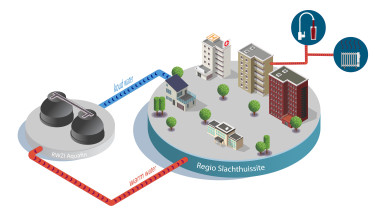Firstly, Antea Group was responsible for variant analysis and determining the optimal technical combination of heat sources, taking into account the phased connection of future heat demand. In the assessment, we took into account the technical requirements and security of supply, sustainability requirements, cost efficiency and flexibility of the concept.
Secondly, we prepared a meticulous business case for supplying heat to the district heating network. A detailed overview of all costs (CAPEX, OPEX) and revenues was made and this was based on a thorough process simulation of each of the variants. Heat demand and supply were optimally matched on an hourly basis, in line with the technical requirements and efficiency of a two-stage heat pump - a type of high-temperature heat pump - under different operating conditions.
As the third part of the assignment, we studied the impact of expansions on heat production and distribution, both technically and financially. This involved taking a closer look at the following:
- What adjustments are needed to the technical concept and what additional investments are required to future-proof the plant?
- Technical concept and additional investments for heat distribution via the district heating network (such as transfer stations, additional controls, booster stations, etc.).
- Impact on the internal installations at Aquafin's WWTP..
Finally, we conducted sensitivity analysis of all risk factors (e.g. effluent temperature, co-firing, heat pump phasing, etc.) that affect the Seasonal Performance Factor (SPF) of the heat pump and profitability of the project. That factor determines the efficiency of the two-stage heat pump. The financial model was carefully developed so that the client could easily evaluate the impact of different parameters on sensitivity.



